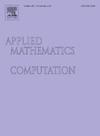Out-of-equilibrium inference of feeding rates through population data from generic consumer-resource stochastic dynamics
IF 3.5
2区 数学
Q1 MATHEMATICS, APPLIED
引用次数: 0
Abstract
Statistical models are often structurally unidentifiable, because different sets of parameters can lead to equal model outcomes. To be useful for prediction and parameter inference from data, stochastic population models need to be identifiable, this meaning that model parameters can be uniquely inferred from a large number of model observations. In particular, precise estimation of feeding rates in consumer-resource dynamics is crucial, because consumer-resource processes are central in determining biomass transport across ecosystems. Model parameters are usually estimated at stationarity, because in that case model analyses are often easier. In this contribution we analyze the problem of parameter redundancy in a multi-resource consumer-resource model, showing that model identifiability depends on whether the dynamics have reached stationarity or not. To be precise, we: (i) Calculate the steady-state and out-of-equilibrium probability distributions of predator's abundances analytically using generating functions, which allow us to unveil parameter redundancy and carry out proper maximum likelihood estimation. (ii) Conduct in silico experiments by tracking the abundance of consumers that are either searching for or handling prey, data then used for maximum likelihood parameter estimation. (iii) Show that, when model observations are recorded out of equilibrium, feeding parameters are truly identifiable, whereas if sampling is done solely at stationarity, only ratios of rates can be inferred from data (i.e., parameters are redundant). We discuss the implications of our results when inferring parameters of general dynamical models.
从一般消费者-资源随机动力学的种群数据推断摄食率的非均衡
统计模型通常在结构上无法识别,因为不同的参数集可能导致相同的模型结果。为了从数据中进行预测和参数推断,随机总体模型需要是可识别的,这意味着模型参数可以从大量模型观测中唯一地推断出来。特别是,准确估计消费者-资源动态中的摄食率至关重要,因为消费者-资源过程是确定生态系统间生物量运输的核心。模型参数通常以平稳性估计,因为在这种情况下模型分析通常更容易。在这篇贡献中,我们分析了多资源消费者-资源模型中的参数冗余问题,表明模型的可识别性取决于动力学是否达到平稳。准确地说,我们:(i)利用生成函数解析计算捕食者丰度的稳态和非平衡概率分布,这使我们能够揭示参数冗余并进行适当的最大似然估计。(ii)通过跟踪寻找或处理猎物的消费者的丰度进行计算机实验,然后将数据用于最大似然参数估计。(iii)表明,当模型观测在非平衡状态下记录时,进料参数是真正可识别的,而如果仅在平稳状态下进行采样,则只能从数据中推断出比率(即参数是冗余的)。我们讨论了在推断一般动力学模型参数时我们的结果的含义。
本文章由计算机程序翻译,如有差异,请以英文原文为准。
求助全文
约1分钟内获得全文
求助全文
来源期刊
CiteScore
7.90
自引率
10.00%
发文量
755
审稿时长
36 days
期刊介绍:
Applied Mathematics and Computation addresses work at the interface between applied mathematics, numerical computation, and applications of systems – oriented ideas to the physical, biological, social, and behavioral sciences, and emphasizes papers of a computational nature focusing on new algorithms, their analysis and numerical results.
In addition to presenting research papers, Applied Mathematics and Computation publishes review articles and single–topics issues.

 求助内容:
求助内容: 应助结果提醒方式:
应助结果提醒方式:


